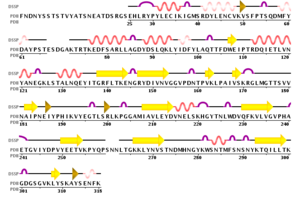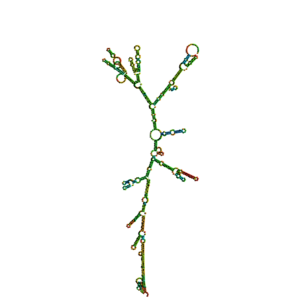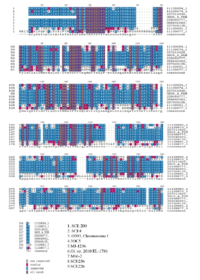Vibrio cholerae colonization factor TcpF
From Proteopedia
(Difference between revisions)
| (One intermediate revision not shown.) | |||
| Line 28: | Line 28: | ||
[[Image:Msatcpf.png|left|200px|thumb| Multiple Sequence Alignment, generated by Biology Workbench [[1xtc]]]] | [[Image:Msatcpf.png|left|200px|thumb| Multiple Sequence Alignment, generated by Biology Workbench [[1xtc]]]] | ||
[[Image:Phylogentic tree tcp.png|left|200px|thumb| Phylogenetic tree-Tcp, generated by Biology Workbench [[1xtc]]]] | [[Image:Phylogentic tree tcp.png|left|200px|thumb| Phylogenetic tree-Tcp, generated by Biology Workbench [[1xtc]]]] | ||
| - | + | {{Clear}} | |
The environmental TcpF proteins are important for secretion because they retained a high degree of identity in the region. Each of the environmental TcpF proteins examined was secreted from the pathogenic strains. Now, TcpF genes from six pathogenic strains of V. cholerae have been sequenced, and all of these strains have nearly identical TcpF amino acid sequences.However, studies examined that environmental TcpF proteins cannot mediate colonization in the infant mouse cholera model. By comparing the environmental strain, SCE4 and the pathogenic TcpF, O395 (See Multiple sequence alignment result ), it revealed that the regions, divergent from one another are located at the middle of the C terminal domain. Therefore, lack of colonization mediated by environmental TcpF proteins may suggest that the divergent regions between the pathogenic and environmental proteins are essential for TcpF function. <ref name="map">PMID: 21440558</ref> | The environmental TcpF proteins are important for secretion because they retained a high degree of identity in the region. Each of the environmental TcpF proteins examined was secreted from the pathogenic strains. Now, TcpF genes from six pathogenic strains of V. cholerae have been sequenced, and all of these strains have nearly identical TcpF amino acid sequences.However, studies examined that environmental TcpF proteins cannot mediate colonization in the infant mouse cholera model. By comparing the environmental strain, SCE4 and the pathogenic TcpF, O395 (See Multiple sequence alignment result ), it revealed that the regions, divergent from one another are located at the middle of the C terminal domain. Therefore, lack of colonization mediated by environmental TcpF proteins may suggest that the divergent regions between the pathogenic and environmental proteins are essential for TcpF function. <ref name="map">PMID: 21440558</ref> | ||
| Line 35: | Line 35: | ||
V.cholerae has a variety of proteins in the periplasm, but only a small part are known to be transported across the outer membrane into the extracellular space. The secretion systems (TCP system) is able to recognize their cognate substrates for export. The TCP apparatus is required by the secretion of TcpF. TcpF is absolutely necessary for colonization and V.cholerae pathogenesis. However, The mechanism for the action of TcpF remains to be elucidated.<ref>Genetic Mapping of Secretion and Functional Determinants of the Vibrio cholerae TcpF Colonization Factor Shelly J. Krebs, Thomas J. Kirn and Ronald K. Taylor | V.cholerae has a variety of proteins in the periplasm, but only a small part are known to be transported across the outer membrane into the extracellular space. The secretion systems (TCP system) is able to recognize their cognate substrates for export. The TCP apparatus is required by the secretion of TcpF. TcpF is absolutely necessary for colonization and V.cholerae pathogenesis. However, The mechanism for the action of TcpF remains to be elucidated.<ref>Genetic Mapping of Secretion and Functional Determinants of the Vibrio cholerae TcpF Colonization Factor Shelly J. Krebs, Thomas J. Kirn and Ronald K. Taylor | ||
J. Bacteriol. 2009, 191(11):3665. DOI: 10.1128/JB.01724-08. Published Ahead of Print 20 March 2009.</ref> | J. Bacteriol. 2009, 191(11):3665. DOI: 10.1128/JB.01724-08. Published Ahead of Print 20 March 2009.</ref> | ||
| + | |||
| + | ==3D structures of colonization factor antigen== | ||
| + | |||
| + | See [[Colonization factor antigen]] | ||
== References == | == References == | ||
<references /> | <references /> | ||
Current revision
| |||||||||||




